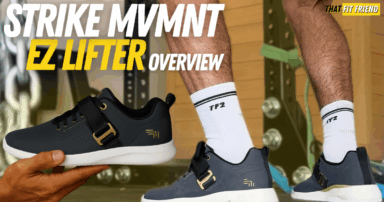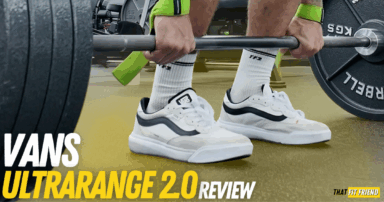That Fit Friend is supported by its readers. I [Jake Boly] run this site myself and buy the gear I review. If you purchase through my site, I may earn commissions on sales, read more here!
The Reebok Nano X is arguably one of the better Reebok Nano models that have ever been released. It promotes stability well across the board and has an added EVA foam forefoot for supporting versatility. With so many Nano models still available, it can be tough to decide which model to go with.
To help you out, I’ve been putting the Reebok Nano X through a variety of tests to help you decide if this shoe is a good fit for you. Compared to the Reebok 9, 8, and so forth, what makes the Reebok Nano X stand out from both a performance and construction point of view?
Who Should Buy the Reebok Reebok Nano X?
The Reebok Nano X is a great cross-training shoe for anyone who prioritizes stability and versatility, respectively, within one training session. This model is a good option for barbell-focused lifters and functional fitness athletes as its construction feeds well into these styles of training.
If you’re someone who wants stability, versatility, a 4mm heel-to-toe drop, and a slightly wider toe box, then I think you’ll benefit well from grabbing a pair of the Reebok Nano Xs.
Reebok Nano X Pros
There are three key features that I enjoy about the Reebok Nano X.
- Stable Outsole
- Great Durability
- Versatile Forefoot Construction
The first thing that I like about the Reebok Nano X is the stable outsole. This model features a stable rubber build with solid traction and has Reebok’s split outsole construction. These construction features provide this model with a great even level of stability throughout the full foot.
Another aspect that I like about the Reebok Nano X is the overall durability. This model has done well from a long-term durability standpoint and the upper construction can hold its own against friction from things like rope climbs in CrossFit WODs. I have seen a few instances of the outsole splitting and breaking after 6+ months of hard training, but those are fairly rare.
The last thing that I like about this model is the high-density EVA foam Reebok uses in the forefoot of this cross-training shoe. This aspect makes this model a good option for things like box jumps, jump rope, and other ballistic movements. It provides a nice balance of versatility with this model’s overall stability.
Reebok Nano X Cons
I like the Reebok Nano X across the board, but there are a couple of cons worth noting for some lifters and athletes.
- Price
- Slightly More Narrow Toe Box (compared to previous Nanos)
The first potential drawback to the Reebok Nano X is the price point. Now, you can generally find colorways and models for less than the $130 price point, but some of the “better looking” colorways are still full-priced, which could be a turnoff for budget-friendly shoppers.
Another potential con to the Reebok Nano X is that the toe box is slightly smaller compared to the Reebok Nano 8 and the previous few models. I don’t find it limiting, and others rarely do, too, but it’s a point that I think is worth mentioning if you skipped the Nano 9 and you’re coming from previous Nano models.
Reebok Nano X Performance
Overall, I enjoy how the Reebok Nano X performs across the board in a variety of settings. I’ve provided my thoughts below on how these cross-trainers perform in lifting, plyometric, and day-to-day/shorter run settings.
Lifting
When it comes to lifting, I enjoy the Reebok Nano X. Despite it having a more versatile and responsive forefoot, the stability is still really solid in this model. For the Reebok Nano X, I’ve squatted up to 380 lbs in this model and have deadlifted up to 485 lbs, and overall, I noticed very little compression.
I like the split outsole construction for providing an adequate base and the midsole does a good job balancing stability across the board.
Agility and Plyometrics
As for agility and plyometrics, I think most lifters and athletes will like how the Reebok Nano X feels and performs. Compared to prior Reebok Nano models, this model feels much more responsive when doing ballistic and bounding style activities and that’s mostly due to the split outsole construction and change in midsole materials.
From a very niche agility and plyometrics point of view, the overall “flat” nature of the Reebok Nano X may not be the best for some athletes, however, I think this will be a very tiny population that is impacted by this.
Day-to-Day/Shorter Runs
On a day-to-day basis, the Reebok Nano X is what you’d expect from a stable cross-training shoe. It won’t be the most comfortable ride in the world, but it does a pretty good job for daily wear and the durable upper helps prolong the life of this model as a whole.
For shorter runs, the Reebok Nano X works and if you’re a functional fitness athlete, then this model will work for the running you experience in your regular training. If you’re looking for a training shoe to support longer bouts of running, I would recommend looking into more niche running shoes.
Sizing and Fit
As for sizing and fit, most athletes and lifters will be safe going true-to-size in the Reebok Nano X. The length and width fit fairly true, but it is worth noting, that the last of this model does appear to be a bit slimmer through the mid-foot and toe compared to models like the Reebok Nano 8.
Price
The Reebok Nano X is a slightly older model, so the price can vary pretty greatly for this shoe. Some colorways are still full price at $130 while others have been marked down.
If you’re interested in the Reebok Nano X, then I would recommend looking into models on both Amazon and Reebok which I’ve linked below.
Construction Details
If you’re interested in the construction details for the Reebok Nano X, I’ve provided the specs that Reebok has listed on their site below.
- Flexweave® woven textile upper
- High-density foam collar
- Designed for: Functional fitness
- Lightweight EVA foam cushioning
- Compression molded midsole
- Minimal drop outsole
Reebok Nano X vs Reebok Nano X1
Unlike the Reebok Nano 9 and Reebok Nano X, the Reebok Nano X1 had a pretty significant construction overhaul.
 ✖ |  ✖ | ➕ Add product to compare | ➕ Add product to compare | ➕ Add product to compare | |
| Overall TF2 Score | |||||
| Stability | |||||
| Versatility | |||||
| Durability | |||||
| Quality | |||||
| Price | |||||
| Best For |
|
| |||
| Review | Link to Review | Link to Review | |||
| Shop | Click to Shop Amazon | Shop This Shoe |
The Nano X1 is very different compared to the X and is much more of a recreational training shoe compared to other hardcore cross-training models.
Takeaway Thoughts
Overall, I enjoy training in the Reebok Nano X and it’s one of my favorite models to date. If you’re in the market for a stable cross-trainer that also provides a decent level of responsiveness, then I think looking into the Reebok Nano X is a good move.








Ashkan
Hello Jake
As usual, I appreciate what you are doing. Between STRIKE MVMNT Haze Trainer, Reebok Nano, and Reebok Nano X2 which one do you prefer for a com flat feet as a first option and second option? The only option for me is online shopping. That is why I only chose shoes based on your reviews. Also, I’m a bodybuilder. Thanks for your great content.